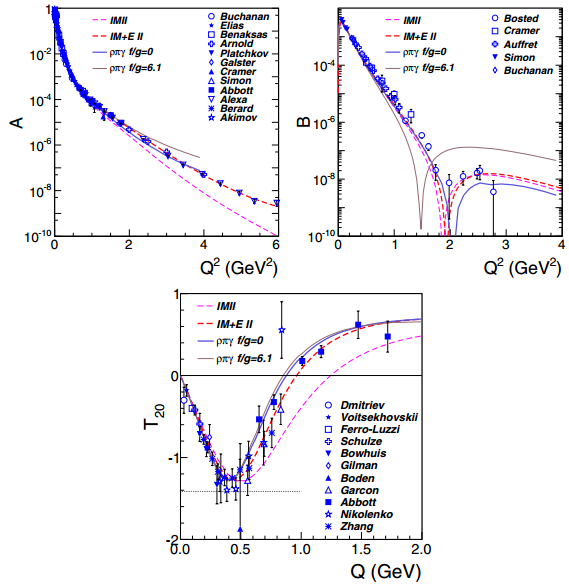Difference between revisions of "Elong-15-02-26"
| Line 3: | Line 3: | ||
Best as I've found, the most recent deuteron form factor parameterization comes from [http://arxiv.org/abs/nucl-ex/0002003 Abbot, et al (2000)], who give parameter equations but not the parameters. They are also using world data from 2001, which is missing a number of new points. | Best as I've found, the most recent deuteron form factor parameterization comes from [http://arxiv.org/abs/nucl-ex/0002003 Abbot, et al (2000)], who give parameter equations but not the parameters. They are also using world data from 2001, which is missing a number of new points. | ||
| − | [[Image:2015-02-26-d-em-ff.png|300px]] | + | [[Image:2015-02-26-d-em-ff.png|300px]] [[Image:2015-02-26-d-t20.png|300px]] |
| − | |||
| − | [[Image:2015-02-26-d-t20.png|300px]] | ||
I talked with Ron Gilman, who has kindly passed on world data from 2012 as summarized in [http://iopscience.iop.org/0034-4885/75/8/086301/ Holt & Gilman (2012)]. In particular, he noted that low Q^2 t20 measurements could be invaluable for confirming that we understand the target tensor polarization, as <math>t_{20}</math> is best known experimentally and theoretically in the 0<Q<sup>2</sup><0.4 (GeV/c)<sup>2</sup> region, which coincides with what will likely be the "cheapest" points. | I talked with Ron Gilman, who has kindly passed on world data from 2012 as summarized in [http://iopscience.iop.org/0034-4885/75/8/086301/ Holt & Gilman (2012)]. In particular, he noted that low Q^2 t20 measurements could be invaluable for confirming that we understand the target tensor polarization, as <math>t_{20}</math> is best known experimentally and theoretically in the 0<Q<sup>2</sup><0.4 (GeV/c)<sup>2</sup> region, which coincides with what will likely be the "cheapest" points. | ||
Revision as of 09:33, 26 February 2015
Deuteron Form Factors Parameterization
Best as I've found, the most recent deuteron form factor parameterization comes from Abbot, et al (2000), who give parameter equations but not the parameters. They are also using world data from 2001, which is missing a number of new points.
I talked with Ron Gilman, who has kindly passed on world data from 2012 as summarized in Holt & Gilman (2012). In particular, he noted that low Q^2 t20 measurements could be invaluable for confirming that we understand the target tensor polarization, as <math>t_{20}</math> is best known experimentally and theoretically in the 0<Q2<0.4 (GeV/c)2 region, which coincides with what will likely be the "cheapest" points.
I'm now in the process of redoing the Abbot parameterization for the most recent data sets for use in getting the elastic cross section estimates for Azz.



